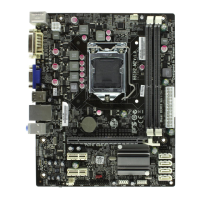
Do you have a question about the ECS H61H2-I2 and is the answer not in the manual?
| Form Factor | Mini-ITX |
|---|---|
| Socket | LGA 1155 |
| Chipset | Intel H61 |
| Memory Slots | 2 x DIMM |
| Maximum Memory | 16 GB |
| Storage Interface | 4 x SATA 3Gb/s |
| Memory Support | DDR3 1333/1066 MHz |
| Expansion Slots | 1 x PCIe x16 |
| USB Ports | 8 x USB 2.0 |
| Audio | Realtek ALC662 |
| LAN | Realtek RTL8111E Gigabit LAN |
| Video Output | HDMI, VGA |
| Power Connector | 24-pin ATX |
Covers copyright laws, warranty disclaimers, and trademark acknowledgments.
Details FCC rules for digital devices and potential interference.
States compliance with FCC rules, Canadian regulations, and provides a manual structure summary.
Details the motherboard's capabilities, socket type, chipset, memory support, and I/O ports.
Describes expansion slots, onboard LAN features, and the purpose of BIOS firmware.
Essential safety guidelines for handling the motherboard and selecting a compatible case.
Explains how to set and check motherboard jumpers for correct system configuration.
Step-by-step guide for installing CPU, memory modules, and expansion cards.
Instructions for connecting I/O ports, front panel headers, and power connectors.
Introduces the BIOS Setup Utility, its functions, and basic navigation methods.
Details settings in Advanced, Chipset, M.I.B III, Boot, Security, and Exit menus.
Provides instructions for downloading and installing updated BIOS firmware.
Guides through installing drivers and software using the support DVD or manual methods.
Explains the functionality of ECS utilities like eSF, eDLU, and eBLU for system management.
Offers troubleshooting tips for common startup issues during assembly and after use.
Provides PC maintenance advice and a flowchart for diagnosing hardware problems.
